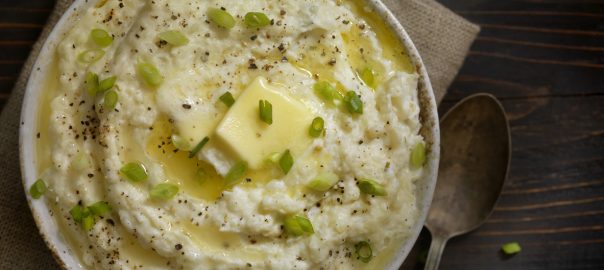
Low Carb Potato Substitutes
Pitching the Potatoes – Low Carb Alternatives
That’s mashed cauliflower – who would have thought!?
For centuries, meat and potatoes have been a way of life; a mantra of meal planning so deeply engrained in our collective psyche, that it’s almost a religion. But potatoes are a high glycemic side dish and could bring you out of ketosis very quickly. The answer? We have seven below.
- Cauliflower (2g net carbs per cup)
Cauliflower is quickly becoming the superstar of the low carb world, with many people praising it for its similarity to mashed potatoes, rice and even pizza crust when prepared certain ways.
This cruciferous vegetable can imitate more starchy, high carb vegetables due to its similar texture and bland (versatile!) flavour. Other great transformations could include cauliflower breakfast hash, cauliflower grilled cheese, cauliflower mac and cheese, cauliflower fried rice, buffalo cauliflower bites, cauliflower chowder, or even cauliflower eggs benedict. We support getting creative and coming up with your own recipes incorporating cauliflower. The possibilities are endless!
Or, try out this recipe for cauliflower tater tots—you’re welcome!
- Cut a head of cauliflower into small chunks
- Steam the chunks over boiling water on the stove
- Remove from heat and strain the cauliflower, then place it in a bowl and mash.
- Mix in 2 beaten eggs, half a cup of parmesan (or dairy-free alternative), and onion or garlic to taste.
- Form the mixture into bite size balls and bake at 400° for about 20 minutes or until golden brown.
Other Benefits of Cauliflower
- High in fibre for good digestive health
- High in B vitamins
- High in antioxidants that can protect against cancer
- Can improve learning and memory
- Helps the liver produce detoxifying enzymes (try some cauliflower in the morning, after an “eventful” night)
- Contains almost as much Vitamin C as oranges
- Turnips (4g net carbs per cup)
A turnip looks similar to a radish that is mostly white with a purple top. Bright colours like this in vegetables and fruits are always a good indicator of a rich nutrient profile! Turnips are related to other cruciferous vegetables such as broccoli, brussels sprouts and kale, but their texture can resemble that of potatoes and other root vegetables.
When buying turnips, make sure to choose ones that are small but heavy for their size. This will ensure they are sweeter and milder in flavour and have a higher water content (drinking water is not the only way to hydrate your body!). Make sure to store them in a cool, low-light area to mimic their natural subterranean environment and maintain their freshness.
Challenge yourself to making classic potato dishes with turnips instead! Some ideas include: oven roasted turnips, turnip gratin, turnip latkes, slow cooker turnips, turnip soup, or mashed turnips with bacon bits.
Other Benefits of Turnips
- High in fibre which can help relieve intestinal problems
- Promotes bowel health
- High in antioxidants that can protect against cancer
- Contains important minerals such as iron, zinc and folate
- Promotes healthy bones
- Can prevent eyesight problems
- Daikon (2g net carbs per cup)
Daikon is a type of radish that looks like a large white carrot. However, unlike the more common small red radishes that have a characteristic peppery and potent taste, the daikon radish is milder, sweeter and crispier.
Due to its high-water content (85%-95% depending on preparation), daikon is a perfectly crunchy low-carb addition to salads, which will make them feel a lot more satisfying. It can also be added to soups, stews and curries. Warm and comforting dishes like these are especially great because daikon tends to be in season in the wintertime. But unlike a lot of high-carb starchy vegetables we’re used to eating around the holidays – like squash, potatoes, and pumpkin – daikon will not raise your net carb intake drastically.
Other Benefits of Daikon
- High in B vitamins and Vitamin C
- High in fibre (helps digestion)
- Has fat burning properties
- Boosts immunity (another reason to consume in the wintertime)
- Has anti-inflammatory properties
- Helps detoxify the body
- Nourishes skin due to high mineral and water content
- Kohlrabi (2 g carbs/27 calories per 100 g)
Here’s a riddle for you…
Q: Which vegetable looks like a large green or purple turnip, grows above the ground like a cabbage, and tastes similar to broccoli stems?
A: Kohlrabi!
Kohlrabi is not considered a root vegetable, despite its similar appearance to radishes and turnips. It actually falls within the same category as cabbage, broccoli, cauliflower and other vegetables that grow above ground. When eaten raw, kohlrabi has a slight crunch and spicy taste similar to a radish or turnip, but it is sweeter and milder. Smaller kohlrabi usually taste sweeter than larger ones, as this vegetable develops a more potent radish-like taste the further it matures. This mysterious vegetable can also be roasted, steamed, baked, stuffed, made into fritters or pureed into a soup. These methods of cooking will bring out more of the sweet, mild flavours of kohlrabi, similar to the beloved potato. But all this talk about sweetness does not mean that it is a high glycemic vegetable – kohlrabi can safely be consumed by those looking to watch their carb intake.
Other Benefits of Kohlrabi
- Helps to prevents anemia due to its high iron content
- Improves vision
- Boosts energy levels
- Increases the metabolism
- High in fibre (helps digestion)
- Has anti-cancer properties
- Rutabaga (5g net carbs per cup)
A cross between a cabbage and a turnip, a rutabaga is a sweet and nutritious root vegetable. Similar to the other items on this list, it can be eaten both raw and cooked in a variety of ways.
Try these roasted rutabaga fries to see for yourself:
- Peel a rutabaga and cut into long thin strips like fries.
- Toss with olive oil, salt, pepper and whichever other seasonings you like.
- Lay the pieces flat on a baking pan with parchment paper.
- Place in the oven for 25–35 minutes at 400° or until your desired crispiness is achieved.
You can try adding some flavour with the following Hot Mamas Spice Mixes and Rubs that are zero sodium and sugar free. Adding spice mixes to recipes can transform the same basic, healthy ingredients into a number of different dishes.
Other Benefits of Rutabaga
- High in vitamins B, C and E
- High in iron
- High in antioxidants that may prevent premature aging
- Can improve eyesight
- Promotes good bone health
- Stimulates healthy regeneration of cells throughout the body
- Has anti-cancer properties
- High in fibre to promote digestive and bowel health
- Celery Root (7g net carbs per cup)
Did you know you can eat the roots of celery, too? Also called celeriac, the celery root grows beneath the ground and is packed with nutrients from the soil. It has a comparable earthy texture and taste similar to a turnip, but also slightly reminiscent of the celery that grows from it.
Try it in a slow cooker to add some hearty nutrients to big-flavour dishes. Or, it could be used in a side dish by cutting or grating it into fine pieces to form a fresh tasting coleslaw or light salad. For something similar but a bit more culinarily challenging, you can search recipes for its classic use in French remoulades.
Other Benefits of Celery Root
- Boosts the immune system
- High levels of Vitamin C help heal wounds
- Vitamin B5 helps keep skin healthy and smooth
- Other B vitamins can reduce risk of Parkinson’s disease
- Reduces arthritis and inflammation
- Promotes good bone health
- High in fibre to promote digestive and bowel health
- Zucchini (2g net carbs per cup)
Zucchini is technically a fruit, but it can still be a great replacement for starchy vegetables in various kinds of recipes. Its mild sweetness and floral taste is great in herby recipes. Its earthier flavours come out when its oven roasted, pan fried or grilled.
Zucchini noodles have become increasingly popular in recent years. While this isn’t exactly a potato substitute – it’s a great carb substitute in general and can be paired with delicious meat sauces to make your own homemade zucchini Bolognese or zucchini lasagne!
Other Benefits of Zucchini
- Can help cure asthma
- Helps balance thyroid function
- High levels of important minerals such as calcium, iron, magnesium and potassium
- Good for eyesight
- High in antioxidants (especially in the skin of the zucchini) that can slow down aging and prevent certain cancers
- High fibre content contributes to healthy digestion
- High in soluble fibres can promote gut health
Goodbye, Spuds. Hello, Low Carb Goodness!
It may be surprising to learn about the different superfoods that exist out there, especially when you are used to your routine of meat with potatoes. But there are so many other nutritious and tasty veggies out there that won’t leave you missing anything about the high carb vegetables of your past.
Stay Connected
If you try out any new recipes with these potato substitutes, we’d love to know! Share your photos and recipes with us on Facebook or tag us on Instagram. We also love to stay connected with our Weekly Newsletters for updates on the latest products and special sales. And please leave us a Google Review with any and all of your feedback!






